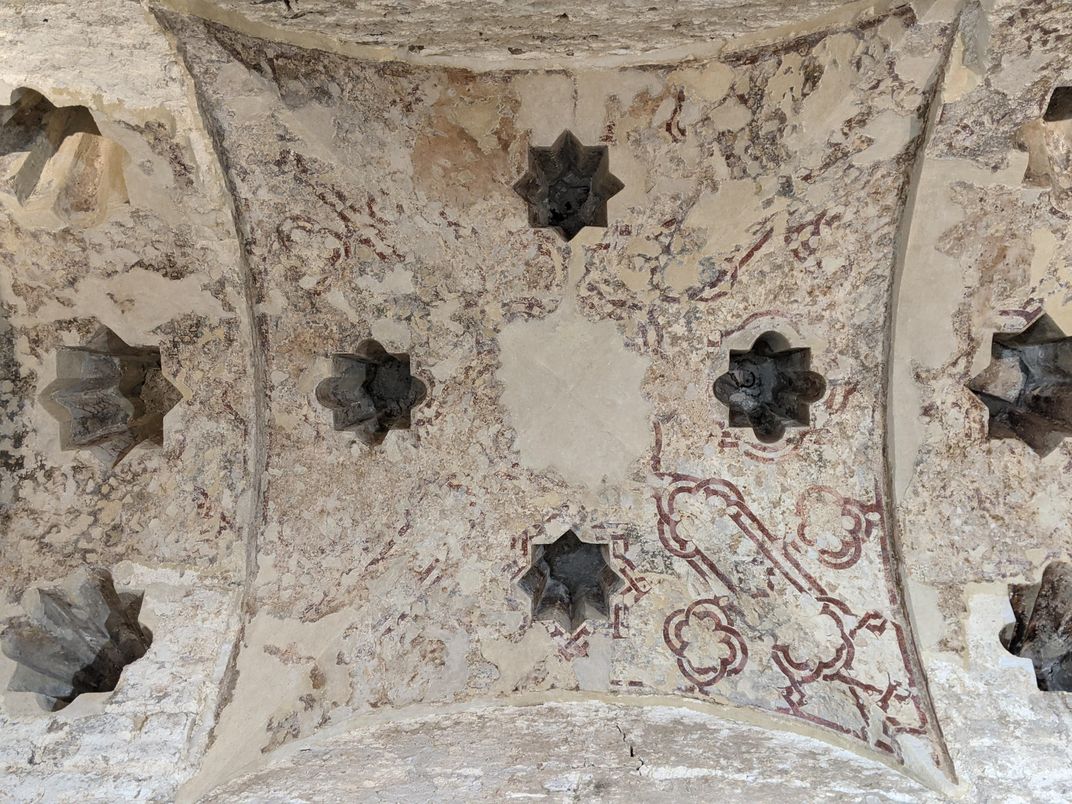Archaeologists Discover 12th-Century Bathhouse Hidden in Spanish Tapas Bar
The Seville establishment’s owners uncovered traces of the historic structure while conducting renovations
:focal(1804x1612:1805x1613)/https://tf-cmsv2-smithsonianmag-media.s3.amazonaws.com/filer/34/a7/34a7b500-dde8-45c5-853b-1d71760fa297/pxl_20210211_075622472.jpg)
Last summer, the owners of Cervecería Giralda, a popular tapas bar in Seville, Spain, embarked on a long-delayed renovation of their almost 100-year-old establishment. But when workers began shaving away at plaster on the ceiling, they discovered an unexpected surprise: the star-shaped skylights of a 12th-century Islamic bathhouse.
“As soon as we saw one of the skylights, we knew what it was,” Álvaro Jiménez, one of the archaeologists brought in to investigate the find, tells the Guardian’s Sam Jones. “[I]t just couldn’t have been anything but a bath. We just had to follow the pattern of the skylights.”
According to Margot Molina of El País, architect Vicente Traver converted the public bathhouse, or hammam, into a hotel during the early 20th century. (The tapas bar opened in 1923.) He took care to hide and protect the historic structure, which fused Islamic architectural traditions with Roman bathing rituals, by covering its features with a layer of modern decoration, reports Jack Guy for CNN.
Though popular lore indicates that a bathhouse once stood at the site, Jiménez and many other locals had written this claim off as a rumor, notes the Guardian. Now, archaeologists have revealed definitive evidence of the well-kept bathhouse, from its ornate geometric embellishments to its shaped skylights and tranquil paintings.
“The most important thing is that we realized the bath was completely painted, from top to bottom, with high-quality geometric decoration,” Jiménez tells El País. “The drawings were made in red ocher on white, and large fragments were preserved on the walls and vaulted ceilings.”
He adds, “This is the only surviving Arab bath with an integral decoration; until now, the only known examples had paint just on the baseboards.”
Excavations uncovered a total of 88 skylights in various sizes and shapes, including stars and octagons. While most hammams only have one or three rows of skylights, this venue boasts five. Per El País, another prominent feature is the bathhouse’s warm room, which is decorated with paintings in a “zigzagging style” evocative of water.
“Nearly all the representations in the Islamic world allude to paradise,” archaeologist Fernando Amores tells El País.
Found across Europe, the Middle East and North Africa, hammams often feature mosaics, fountains and pools. Because of restrictions on depictions of human and animal subjects in Islamic art and architecture, bathhouse decorations mainly portray geometric and floral shapes or calligraphy, according to El País’ Javier Arroyo.
Per Encyclopedia Britannica, most bathhouses have multiple sections, including a warm room, a hot room and a steam room. Today, the central space that once served as the bath’s warm room houses Cervecería Giralda’s bar. Four columns support its eight-sided vaulted ceiling, which opens up into a 13- by 42-foot rectangular side chamber formerly known as the bath’s cold room. Experts speculate that the bar’s kitchen used to house the hammam’s hot room, but the only surviving trace of the space is a sliver of an arch, reports El País.
The hammam dates back to the Almohad Caliphate, a North African Islamic empire that ruled most of the Iberian Peninsula between 1130 and 1269 A.D. As Isambard Wilkinson writes for the London Times, the first documentary evidence of the Seville bathhouse dates to a few decades after Christian forces’ capture of the city in 1248. Per CNN, archaeologists plan to use carbon dating to further pinpoint the timing of the hammam’s construction.
During the 17th century, “[t]he building was ‘Italianized’ and the original columns, probably made from reused Roman columns, were replaced with others made with Genoese marble,” Jiménez tells El País. “All the skylights were shut.”
He adds, “Our theory is that it became the premises for a merchant who built his home over the shop.”
Once restoration work ends next month, the bar will reopen to the public. Its owners hope that the new discovery will add to the restaurant’s character.
“This was a pretty well-known bar before,” co-owner Antonio Castro tells the Guardian, “but now people will be able to come in and have a beer or a glass of wine in a bar that’s also a 12th-century hammam.”
/https://tf-cmsv2-smithsonianmag-media.s3.amazonaws.com/accounts/headshot/Isis_Davis-Marks_thumbnail.png)

/https://tf-cmsv2-smithsonianmag-media.s3.amazonaws.com/filer/03/1a/031aeb07-6799-4734-8cc8-dcde18e636e3/b.jpg)
/https://tf-cmsv2-smithsonianmag-media.s3.amazonaws.com/filer/2e/14/2e14d26d-b563-40e2-a5e0-355970da7230/pxl_20201210_171244221.jpg)
/https://tf-cmsv2-smithsonianmag-media.s3.amazonaws.com/filer/43/f5/43f5c794-7bfe-400f-8a07-260c54bb16fe/c.jpg)
/https://tf-cmsv2-smithsonianmag-media.s3.amazonaws.com/accounts/headshot/Isis_Davis-Marks_thumbnail.png)